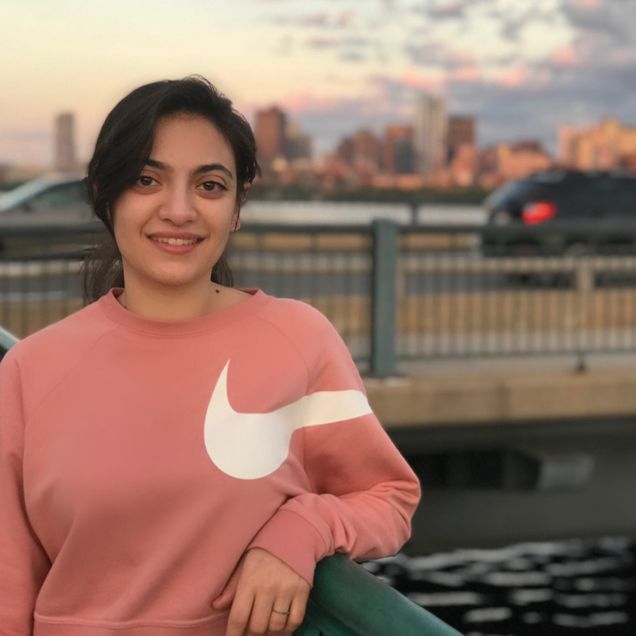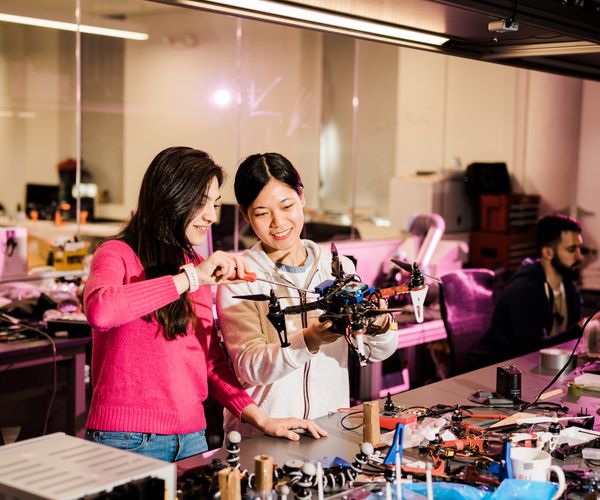“Systems engineering is a field that is constantly on the brink of the unknown,” says Mahroo Bahreinian, a fourth-year PhD candidate (SE) at Boston University. “Researchers work on solving problems that no one else has thought of and their research is always cutting-edge and evolving. It allows me to constantly learn new things and develop novel theories.”
At Boston University College of Engineering, Bahreinian is working under Roberto Tron, Assistant Professor (ME, SE), on the prestigious Multidisciplinary University Research Initiative (MURI) grant from the Department of Defense entitled Neuro-Autonomy: Neuroscience-Inspired Perception, Navigation, and Spatial Awareness for Autonomous Robots. The project allows Bahreinian to learn about how living organisms move and what sparks their neurons, enabling them to navigate through an environment. The grant observes different biological systems from insects to birds to rodents to humans. Researchers learn from each organism’s capabilities and then work to implement them into robots.
Bahreinian is also working on novel path planning methods. The work involves designing a controller that allows autonomous robots to operate in dynamic environments using the environment’s measurements. If the environment becomes deformed, the same controller would still be able to move from the start point to the goal point. Her research is developing new algorithms for AVs to navigate through complex environments “by observing small parts of an environment rather than an entire map of it.” The accuracy of path planning is crucial for the safety and efficiency of AVs as it helps the vehicles successfully navigate and avoid collisions.
The research uses observations from living organisms to adapt to changes in the environment. “When humans navigate, there is no GPS or map of an environment; however, humans are still able to navigate from point A to point B,” explains Bahreinian. “If something in the environment changes, say a chair is moved, humans are able to adjust and continue on to reach point B.” By observing how humans react to a new obstacle, Bahreinian’s team takes into account collision avoidance. “We use mathematical methods to prove that our controller is robust to changes in the environment and that the robot can still navigate through an environment.” Each biological system offers different capabilities that researchers are trying to develop for future autonomous vehicles.
This is in contrast to traditional path planning methods, which use a map of the environment and assume that the map displays all obstacles. In traditional methods, an optimal path is chosen using the knowledge from the map to navigate a vehicle from start to goal point.
Besides working on the MURI grant, Bahreinian interned as a data scientist last summer at iRobot, a developer of autonomous vacuums. There her work focused on machine learning to identify customer-specific insights and recommendations on vacuum usage. By collecting data from the vacuums and classifying customers into different groups based on how they used their vacuums, Bahreinian’s work identified more efficient ways for customers to use their iRobot vacuums.

“In industry, you can see the results of your work almost instantaneously, in real-world applications through changes in revenue or customer satisfaction,” says Bahreinian. “That’s different from academia where you work on solving a problem and the result is publishing a paper.”
Bahreinian decided to pursue her PhD in systems engineering because of the field’s vast research possibilities, “there are constantly opportunities to collaborate with different departments; you can work with professors in mechanical engineering, computer science, mathematics.” The number of departments students can work with enables them to choose a research topic that involves a myriad of disciplines and broaden their knowledge. For Bahreinian who enjoys being on the frontier of new developments and research, systems engineering has allowed her to continually work on novel, innovative projects.
To first-year PhD students, Bahreinian advises doing a lot of research before deciding what you want to study, “read papers, do rotations with different professors and advisors to see what they’re doing, and figure out what you’re interested in. The best part of being a PhD student is that you’re getting paid to improve your knowledge. You should take advantage of this.”
Bahreinian completed her undergraduate studies at Sharif University in Iran where she majored in Aerospace Engineering with a focus on flight dynamics and control. Outside of the lab, Bahreinian enjoys photography as well as hiking and biking around New England.
